#the cultural politics of gender will not line up with the intra-community politics of gender for a very very long time
Text
As important as i think it is to understand that not everyone at risk of an unwanted pregnancy is a woman, and use appropriate language to reflect that, i also think it is really critical that we do not let trans-inclusivity stop us from understanding or articulating that overturning roe v. wade is an act that is intended to harm women categorically.
It’s not all-encompassing. obviously there are plenty of women who can’t get pregnant, regardless of assigned sex. obviously some people who get pregnant are not women. But we do need to discuss the fact that it’s legislation designed to harm and control women, because the desire of the christian right always has been and always will be to make women (and by extension, people they view as women) second class citizens.
and if we can’t find a way to recognize and talk about the ways in which women as a social category are still at risk and being specifically targeted then we de facto cede the entire feminist movement to violent transphobes. which i really really do not want. regardless of any personal identity politics and pontificating about what it does or doesn’t mean to be a woman, there is still a cultural concept of who and what women are that we do not have the luxury of fully opting out of even if we’d really like to. we have to be able to simultaneously discuss macro-scale gender politics And individual identity if we want to have a trans-inclusive feminist movement, rather than just a trans inclusive movement Or a feminist movement.
#if this post starts to pick up at all i am just going to delete it#need to get this one off my chest but i do not want to deal with the discourse it will inevitably bring if it breaches containment#but like. if you see some well-meaning cis woman say 'its a scary time to be a woman' she's not wrong and not necessarily being transphobic#just because it is also scary for people who Aren't women doesn't mean we can categorically abandon women as a marginalized class of people#who are worth discussing as a whole.#because yes it is a scary time to be a woman.#and that includes trans women! because obviously as much as the christian right likes to claim they view them as men they categorically dont#discussing the positioning of trans people in the eyes of a cultural force that refuses to recognize them is insanely difficult but#it is work that Can be done without us filling in 'afab' whenever they say 'women' because its just not that simple#the cultural politics of gender will not line up with the intra-community politics of gender for a very very long time
213 notes
·
View notes
Text
How Apollo 8 Delivered Christmas Eve Peace and Understanding to the World
https://sciencespies.com/history/how-apollo-8-delivered-christmas-eve-peace-and-understanding-to-the-world/
How Apollo 8 Delivered Christmas Eve Peace and Understanding to the World

It was the final months of 1968 and throughout the year, the stability of American democracy had been called into question again and again. When Reverend Martin Luther King Jr. was assassinated in Memphis in April, civil unrest erupted throughout the United States. The “confidence of America’s allies and friends around the world” had been shaken, Leonard Marks, the United States Information Agency (USIA) director told President Lyndon B. Johnson. “We have suffered a blow from which it will take a long time to recover.”
Two months later, on the other side of the country, presidential hopeful Robert F. Kennedy was fatally shot shortly after he made his California Democratic primary victory speech. Then, in late August, violent clashes between protestors and police at the Democratic National Convention broke out in Chicago, casting more doubt on the U.S. political system. Parallels were quickly drawn between the Chicago riots and the Soviet Union’s suppression of the Prague Spring that same month. At the end of the year the USIA concluded that the Vietnam War, protests, assassinations and upheaval throughout the country led “many persons abroad to question whether the vaunted American system might be on the verge of decay and disintegration.”
Tear gas, body counts, protests and riots all appeared on television sets around the globe and in international newspapers. The House of Representatives Foreign Affairs Subcommittee observed that “the mental picture that many foreigners have of our nation is increasingly that of a violent, lawless, overbearing, even sick society.”
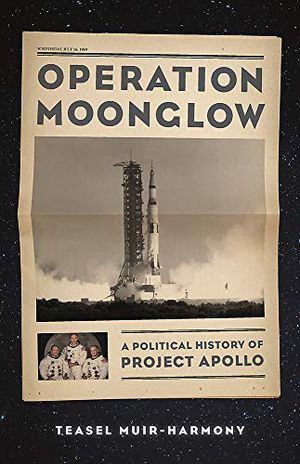
Operation Moonglow: A Political History of Project Apollo
Since July 1969, Neil Armstrong’s first step on the Moon has represented the pinnacle of American space exploration and a grand scientific achievement. Yet, as Smithsonian curator Teasel Muir-Harmony argues in Operation Moonglow, its primary purpose wasn’t advancing science. Rather, it was part of a political strategy to build a global coalition. Starting with President John F. Kennedy’s 1961 decision to send astronauts to the Moon to promote American “freedom” over Soviet “tyranny,” Project Apollo was central to American foreign relations.
Buy
Read More About Apollo 8
Then, in late December, Apollo 8 offered an antidote: an image of a nation striving for grand goals, inclusive and focused on peace and unity. The crew’s broadcasts from the moon would capture the attention of a billion people worldwide. Inclusive language during the broadcasts, as well as the soon-to-be-iconic photo Earthrise, amplified the USIA and State Department messaging that the American space program was “for all mankind.” When the world felt divided—between democracy and Communism, among generations, races and genders—it would be Apollo 8 that would offer a moment of unity and a sense of connection.
From the start, Apollo 8 commander Frank Borman understood his flight and then later promotion of the space program abroad as part of his service to the country, not as a purely scientific pursuit: “If you think I would’ve devoted that much of my life simply to exploration or science, I wouldn’t have, I’m not built that way, that’s not my thing.” The cold war threatened the security of the U. S., and his role as an astronaut was part of confronting that threat, lessening Soviet influence on the geopolitical landscape.
Shortly before his launch, as Borman engrossed himself in training, his phone rang. It was Julian Scheer, NASA’s deputy administrator for public affairs.
“Look, Frank,” Borman recalled Scheer explaining. “We’ve determined that you’ll be circling the Moon on Christmas Eve and we’ve scheduled one of the television broadcasts from Apollo 8 around that time.” Scheer pointed out that more people would hear the crew’s voices than had heard any voice in history. NASA estimated that a billion people around the world would be following the flight. He then added the simple but imposing instruction: “So, we want you to say something appropriate.”

One in four people on Earth—roughly a billion people spread among 64 countries—listened to the broadcast on Christmas Eve from Apollo 8 (from left: James A. Lovell Jr., command module pilot; William A. Anders, lunar module pilot; and Frank Borman, commander).
(NASA S68-50265)
For help, Borman turned to his friend Simon Bourgin, the USIA science advisor. The two had become close during the Gemini 7 diplomatic tour of Asia. When Borman prepared for interviews, he would ask Bourgin for advice.
Bourgin suggested a simple and short broadcast. “With six television transmissions, you are overexposed . . . and with that much time you could be tempted to pad, ham it up, or try to entertain. Avoid all of these.” In other words, he explained, “Keep your audience hungry.”
For the Christmas Eve broadcast, start with a description of what you see, he suggested: “I have a feeling that any direct message that you might compose reflecting on Christmas Eve, conditions on Earth, and the way you feel about it at the moon, could get awfully sticky; it would be difficult not to sound pretentious or patronizing.” In its place, end with a quotation.
Bourgin had called his friend Joe Laitin, assistant to the director of the Bureau of the Budget, and his wife, Christine, for advice. Christine came up with the idea of reading Genesis. “Why don’t you begin at the beginning?” she asked.
The first ten verses of Genesis from the Old Testament would have “universal appeal and a sense of reverence that is called for,” agreed Bourgin. As he told Borman, “About the only thing I can think of to match the majesty of the occasion, and the evening, is to read the opening lines of Genesis.” When Borman shared the idea with crewmates James Lovell and William Anders, they also agreed. The passage, typed on fireproof paper, was inserted into the Apollo 8 flight plan.
On December 21, like much of the nation, the first thing on President Lynden B. Johnson’s agenda was to watch the early-morning launch of Apollo 8. At 7:51 a.m. EST, Borman, Lovell and Anders became the first humans to ride the huge Saturn V rocket into space, one of countless firsts that the astronauts would claim on the mission. Susan Borman, Frank’s wife, found it “awesome . . . like watching the Empire State Building taking off.” As the spacecraft glided out toward the stars, the astronauts departed the Earth and stopped experiencing sunrises and sunsets. Another first.
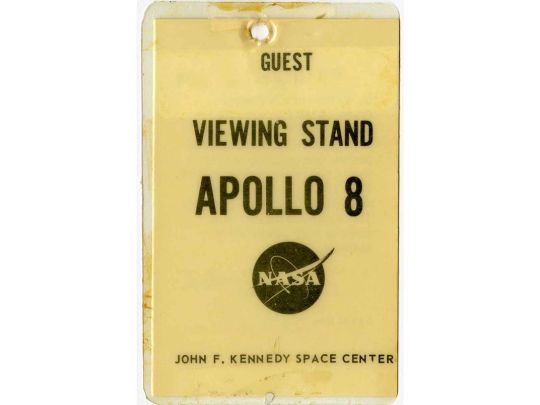
An entry pass to the viewing stand for the Apollo 8 launch at Kennedy Space Center, December 21, 1968, is held in the collections of the Smithsonian’s National Air and Space Museum.
(NASM)

Also in the museum’s collections is Apollo 8 astronaut William Anders’ spacesuit, engineered to provide a life-sustaining environment during unpressurized spacecraft operation.
(NASM)

Lunar module pilot William Anders wore this intra-vehicular glove during the launch of Apollo 8.
(NASM)
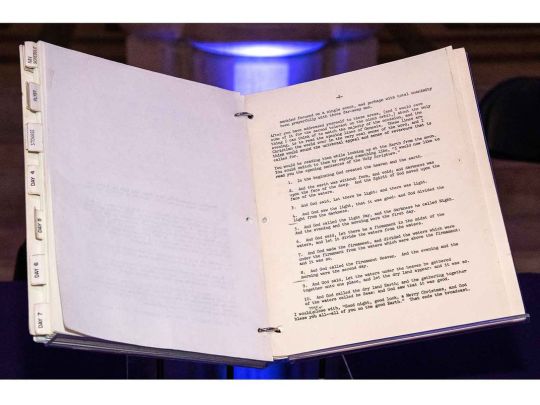
The Genesis scripture that the astronauts read on Christmas Eve 1968 can be found neatly typed in the pages of the Apollo 8 flight plan.
(NASM, courtesy of the Alder Planetarium and Astronomy Museum)

When Apollo 8 astronauts splashed down on December 27, 1968, they were airlifted safely aboard this rescue net to hovering Navy helicopters.
(NASM)

The image Earthrise, taken aboard Apollo 8, swiftly became a culture touchstone, appearing on this bumpersticker and elsewhere across the American landscape.
(NASM)
The mission would prove a boon for American ambassadors and other officials, who were invited by local media for interviews on the flight. “An excellent opportunity to get positive exposure through a variety of media in many countries,” the USIA advised. The agency would record the heaviest placement of its media material in memory, providing hundreds of photos, thousands of feet of TV film, and “reams of copy” to local newspaper, radio and television outlets around the world.
The Voice of America radio network provided live coverage of each stage of the mission, from launch to splashdown, in English, Chinese, Russian, Spanish, Portuguese and Arabic. American embassies in Eastern Europe assembled exhibits in their windows with pictorial explanations and a step-by-step schedule of the flight. As the crew completed stages of the mission, embassy staff would post announcements. The U.S. Embassy in Sofia, Bulgaria, reported that the window display “drew exceptionally large crowds, despite cold and snow.” In warmer climes, inhabitants of Martinique followed radio coverage of the flight so carefully that consulate personnel reported walking down the street and hearing status updates from shopkeepers and acquaintances.
Apollo 8 reached the moon three days later. The crew fired the service module engine, slowing the spacecraft down just enough to put it into orbit around another celestial body, another first. On the fourth orbit, Borman rotated the spacecraft, tilting its nose back toward Earth. Its small windows framed the Earth seemingly rising above the lunar horizon. The view caught the crew by surprise, even though mission planners had anticipated that the moment would come.
“Look at that picture over there!” Anders called out. “Here’s the Earth coming up. Wow, is that pretty!” With a Hasselblad camera in hand, Anders snapped a photo. Most of the photography scheduled for the flight focused on the moon. NASA needed detailed images of potential landing sites for future missions. As Anders watched the Earth rise above the lunar horizon, the black-and-white film magazine mounted to the camera’s boxy body would not do. Only color film could capture the contrast of the gray moon and the bright-blue Earth that Borman called “the most beautiful, heart-catching sight of my life.” Anders called out, “You got a color film, Jim? Hand me that roll of color quick, will you . . . hurry up!” After a swift swap of film magazines, Anders started snapping again.

“Look at that picture over there!” Anders called out. “Here’s the Earth coming up. Wow, is that pretty!” The image Earthrise became one of the most famous of the Space Age.
(NASA )
He caught the Earth above the gray-chalky lunar horizon, the sun illuminating parts of Africa and South America. Eddying clouds suggested an alive, dynamic planet. Earthrise, as the photograph would come to be known, amplified the beauty—and rarity—of humans’ home planet. Shortly after the crew splashed down a few days later, this photograph would grace the front page of newspapers around the world and become one of the most famous images of the Space Age.
Food packed for the crew that day was tied up in fireproof plastic green ribbons and labeled “Merry Christmas.” Inside Borman, Anders and Lovell found turkey with gravy and a fruit-cake coated with gelatin to prevent crumbs from floating into the spacecraft’s systems.
At 9:30 p.m., during the second-to-last lunar orbit of the flight, the crew began their last broadcast from the moon. Taking a cue from Bourgin, they turned the camera toward the moon and took turns describing their perspectives. Borman called the moon a “vast, lonely, forbidding-type existence, or expanse of nothing, that looks rather like clouds.” Lovell agreed, commenting that “the vast loneliness up here of the Moon is awe inspiring, and it makes you realize just what you have back there on Earth.” Anders added, “The sky up here is also rather forbidding, foreboding expanse of blackness, with no stars visible.”
“We are now approaching lunar sunrise,” Anders explained to the television and radio audiences around the world. “For all the people back on Earth, the crew of Apollo 8 have a message that we would like to send to you.” Minutes before the spacecraft slipped behind the moon for the last time, the crew took turns reading from Genesis.
youtube
“In the beginning, God created the heaven and the Earth,” Anders read.
Borman ended the passage, adding “and from the crew of Apollo 8, we close with good night, good luck, Merry Christmas, and God bless all of you—all of you on the good Earth.”
Around the world, television sets glowed with the broadcast. One in four people on Earth—roughly a billion people spread among 64 countries—listened to the reading. Within 24 hours, recorded broadcasts of the address from the moon reached people in another 30 countries. Audiences in North and South America as well as Europe tuned in live thanks to the recently launched Intelsat 3 satellite. Comsat put the satellite into operation a week ahead of schedule so that international audiences could follow the flight.
Frank Borman had at first been skeptical about the addition of heavy television equipment on missions because weight and time were at a premium. But the broadcast, and world reaction, would change his mind. “Probably [the] most important part of space,” he later reflected, “in view of [the] impact on people of the world.”
Reactions to the telecast were unprecedented, and the USIA won a significant public diplomacy victory with the carefully chosen, inclusive wording of the Christmas Eve address. A BBC correspondent commented that the reading “struck on instantly as a stroke of genius.”
In Latin America alone, 1,353 stations carried the VOA broadcast, breaking records. Even Radio Havana picked up VOA coverage, an anomaly for the official Cuban-government–run station known for transmitting programming created by the North Vietnamese, North Koreans and Russians. The station cheered the mission as “a total success.” Borman received some 100,000 letters of appreciation for the Christmas Eve broadcast from around the world, with just 34 letters making complaint.
The Apollo 8 crew had traveled farther and faster than any humans in history. They saw what no other eyes had seen: the far side of the moon, and the Earth from a great distance, blue and white and shining. They became the first humans to ride the mighty Saturn V rocket, break the bonds of Earth’s physical pull, and enter the gravitational field of another celestial body. But the mission, and the program more generally, “did much more than just advance the country scientifically and technically,” Borman, argued. “It advanced it—in my opinion—diplomatically just as much. It cast the country in a favorable light, at a time when there were many things that cast it in an unfavorable light.”
On Christmas Day, the front page of the New York Times carried an essay by the poet Archibald MacLeish inspired by the mission: “To see the earth as it truly is, small blue and beautiful in that eternal silence where it floats, is to see ourselves as riders on the earth together, brothers on that bright loveliness in the eternal cold—brothers who know now they are truly brothers.”
Expert from Operation Moonglow: A Political History of Project Apollo, by Teasel Muir-Harmony. Copyright©2020 by Teasel Muir-Harmony. Published by Basic Books. Reprinted by permission.
#History
1 note
·
View note
Text
On Class, Mainstream Media and the Police State in Jackson, MS and Beyond

Jackson Police Department’s Interim Police Chief Anthony Moore held a press conference on May 30, 2018 announcing the firing of Officer Vincent Lampkin. On May 14, 2018, Lampkin physically assaulted John Knight, III and placed a gun to his head. Not surprisingly, during his press conference, Moore framed Lampkin’s actions as that of a lone bad apple that should not be attributed to the rest of JPD.

The one bad apple explanation for police state violence is an old trope used by the police state to maintain its legitimacy and moral authority in the eyes of the popular masses. It is usually employed when the top brass in a police department has decided that an officer has to be made a sacrificial lamb for acts of violence against a civilian because to do otherwise might damage the entire department’s legitimacy.

Lampkin should have been fired. However, we must be clear about the social, political and economic underpinnings that led to his firing. We must also be clear that Lampkin’s firing alone is not justice, especially in light of the fact that Moore narrowly tailored his public statement on the incident to coincide with the false narrative that Lampkin was a bad apple that does not represent the “good cops” with JPD. JPD systemically perpetuates violence against poor Black people because it is a department comprised of a bunch of bad apples that need to be thrown in the garbage.
“One Bad Apple Spoils the Whole Bunch”
In trying to cast Lampkin as a lone bad apple, Moore must have forgotten about the old saying, “that one bad apple spoils the whole bunch.” JPD has killed four people since November 2017. None of the officers involved in these killings have been held accountable for their actions. In each instance of police violence, JPD has told the public it would conduct an internal investigation or that it was passing the case along to the Mississippi Bureau of Investigation for an “independent” investigation. It has been seven months since JPD’s first victim was killed and the public still knows nothing about the findings of JPD’s investigation or if the officer was even held to account. JPD has refused to release the names of officers who shoot and/or kill civilians and has doubled and tripled down on this position while Mayor Chokwe Antar Lumumba has given them cover while they operate with impunity.
Lampkin’s assault of Knight took place in the context and culture of violence that has been fostered by JPD. This culture was not developed and nurtured overnight. To act as if Lampkin is an aberration within JPD is disingenuous and is an insult to the intelligence of the residents of Jackson. Even if Lampkin was an aberration, why did other “good cops” not come forward and condemn his criminal behavior? It is because JPD is violent to its core. Police officers are trained to control and dominate, not protect and serve.
I am sure that this is not the first time that Lampkin has assaulted someone. Why else would he feel so comfortable brutalizing someone, putting a gun to their head and then cavalierly releasing them as if nothing happened? I know from my experience of representing individuals charged with crimes that JPD routinely assaults persons who are arrested. I have had clients who have been maimed by JPD and they will be brought into court brutalized and no one in the courtroom would ask one question about the person’s appearance except me. This is evidence that every official in this system is complicit in and provides cover for the violent thug operation that is the police state in Jackson and beyond. Officers get away with such violent acts because most of the people they brutalize are poor, Black and powerless. However, this time, Lampkin made the mistake of choosing a victim who society viewed as having great potential in line with society’s classist orientation.

The Role of Classism in the Case of John Knight, III
Class contradictions were apparent in the way that Knight’s assault was handled by the media, society at large and JPD. These glaring class contradictions should not be ignored or taken lightly. Knight is a former Jackson Public Schools student athlete. At the time he was assaulted, Knight was at home on a break waiting to begin school at Utah State University where he won a basketball scholarship to attend. Local media outlets, which have been notorious for engaging in character assassination of individuals killed by JPD, were very careful in how they framed the Knight incident.
In reporting about Knight’s ordeal with JPD, the Clarion Ledger was sure to always refer to Knight as a student athlete and did not take any swipes at his character. However, when Crystaline Barnes, who was also a college student and mother, was killed by JPD officers under dubious circumstances, the publication decided to publish that Barnes had outstanding traffic tickets and that she had previously been in the Hinds County Pre-Trial Intervention program, a probation program that allows individuals to have their charges dismissed if they can pay money to the Hinds County District Attorney’s Office over a 12 month period. Clearly, both were college students, but the difference seems to be that Barnes was a single mother who was not deemed as worthy of sympathy as the student athlete who has “potential” in the eyes of a classist society.
In a press conference called by Knight’s attorney, Dennis Sweet, III, Sweet and Knight’s parents repeatedly made comments that were rooted in respectability and classism. Knight’s father constantly made references to how he taught his son to respect authority, how he came from a “good” home, had a “good” upbringing and had never been in any trouble. Sweet highlighted how Knight was on the dean’s list at Southwest Community College and is the type of young man that Jackson should be proud of. On the surface, these comments appear to be merely statements made by individuals who are interested in getting justice for a client and a son. However, when we go deeper and look at the class dynamics of the society that we live in, the comments made set up a dichotomy that says individuals who are poor, Black, mentally ill, drug addicted and/or convicted felons are less deserving of justice than a young Black man who has the potential to be an American “success” story.
This society has proven time and time again that Black people can be murdered in cold blood, accosted or otherwise harassed no matter what our station in life is. In short, our college degrees, the way we dress, the way we speak or the type of family we come from will never be enough to provide shelter for Black people from the reign of police terror. This is why it is dangerous for anyone to set up, whether it is intentional or unintentional, a classist narrative that centers on an individual’s characteristics, potential, or academic or athletic prowess. There should not be one case where we are not raising the names of all of JPD’s victims and pointing out that this is a systemic problem and not just an issue of a particular incident or case. When we don’t do this, we thwart our own chances for getting closer to establishing a system of justice where no one is mistreated regardless of race, class, gender or sexual orientation.

Crystaline Barnes, Lee Bonner, Elliot Reed and an unidentified Black man were all working class or poor Black people killed by JPD officers. They all had their characters assassinated by JPD and the media after JPD killed them. None of them are less worthy of justice because of their interaction with the so-called criminal justice system are allegations of criminal activity at the time of their killings. Sadly, the deaths of these victims did not raise much concern or outrage in popular discourse and the little motion that was generated surrounding their killings certainly did not result in any officers being fired or criminally punished for their actions. As far as the public knows, none of these officers were criminally indicted, some of the cases likely never even made it before a grand jury.
Working class and poor Black lives are deemed less valuable and worthy of redress. This is an elitist notion that we must vigilantly stand against and repudiate. We must engage in vigorous and unceasing class analysis and struggle. This is the only way that there will be justice for all of JPD’s victims. If Lampkin can be fired for assaulting Knight, there is no reason that the officers who killed the aforementioned victims should not be fired and criminally charged. Instead, they enjoyed a paid vacation on the tax payer’s dime and were allowed to return to work as if nothing ever occurred. That this has happened in a city that touts itself as “the most radical city on the planet” would be laughable if it were not so sad and angering.
The Struggle for justice against police state violence cannot and must not be relegated to the legal realm of civil lawsuits of individual victims or their families. I am not opposed to victims seeking monetary damages, but that cannot and should not be all that is pursued. Police State violence is a systemic issue and must be attacked as such. We must build a political movement to challenge the systemic violence of these gestapo like police departments. This is the only way we can bring police violence to a halt. We must demand that police are disarmed and police departments are disbanded and replaced with institutions that are more just, humane and controlled by the popular masses.
History is evidence that the only solution to police violence is disarmament and disbandment. Police have been killing Black people since the days they were called Slave Patrols. They have been used to subvert worker solidarity and class unity, both interracially and intra-racially. They are used to protect the economic interests of the ruling class elites. Police help to ensure that the popular masses never gain control over their own labor and ultimately, the means of production. The elite classes use the means of production to generate wealth for themselves on the backs of the popular masses. Police place profits, maintaining unjust class relations and the status quo before the wellbeing of people.

Is the Outcome in Knight’s Incident Truly Justice?
Before we get too carried away with celebrating about the firing of Lampkin, we must reflect. The public still does not officially know the truth of what happened to Knight and why. We still don’t officially know whether this was Lampkin’s first time engaging in such criminal behavior. If it was not his first time acting so criminally, why didn’t all of the “good cops” report his criminality? How many other officers have had allegations of this criminal nature brought against them without consequence or repercussions? We don’t know the answers to these questions and we won’t know if we are satisfied with Lampkin’s firing. We must go deeper.
If a civilian was accused of assaulting a law enforcement officer, that civilian would be prosecuted to the fullest extent of the law. Why aren’t Lampkin and other violent cops being prosecuted for their crimes against the popular masses? I have seen countless instances where civilians are charged with aggravated assault on a law enforcement officer when it was clear that the officer had not been accosted. So, if the people are being prosecuted on trumped up charges inside of kangaroo courts, certainly, these violent police officers should be prosecuted as well for their very real crimes committed against the community.
Our Standing Demands
The America Mean Prison Initiative (AMP), a grassroots community effort aimed at addressing police state violence and supporting communities impacted by the violence and dehumanization of incarceration call on the Lumumba administration to do the following: 1) Fire all officers involved in violence against civilians; 2) Establish a use of force policy that includes tangible and direct participation by the popular masses; 3) Release the names of officers involved in acts of violence against residents immediately; 4) Conduct an internal audit into all JPD policies, procedures and practices and allow the popular masses to be involved at every stage of the process; 5) Establish a human rights charter and an elected human rights commission with subpoena and investigative powers to ensure that all civilian’s human rights are respected, protected and fulfilled and 6) Disband the task force appointed by Lumumba because it is not a genuine representation and expression of the popular masses, but instead is little more than an appendage of the state and its’ manipulative machinations of the people.
41 notes
·
View notes
Text
Intersectional Feminism In the Classroom

(Photo Source: These Are The Fierce Activists Leading The Women’s March On Washington)
On both January 21st and 22nd of this year, three women organized the country’s largest political demonstration, drawing in nearly half a million Americans to The Women's March on Washington and over 3 million nationally. These women - Linda Sarsour, Tamika Mallory and Carmen Perez – sought to amplify the voices of all those who find themselves at the mercy of patriarchy’s clenched fists. In addition to the typically advertised causes of feminism including reproductive rights and the gender wage gap, protesters rose signs calling attention to police brutality against black bodies, waved rainbow flags in support of LGBT identifying folks, and called out against the Dakota Access Pipeline. This was a demonstration of third wave feminism. This was intersectional. And despite the valid intra-community criticisms against the actual execution of the Women’s March, I ask what we as educators can take away from this major event and how can we bring what we learned into the classroom?
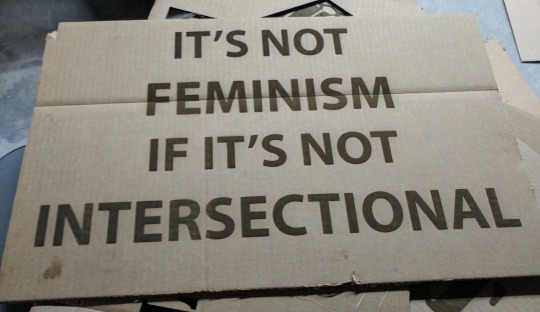
(Photo Source: Do I Have a Place in Your Movement? On Intersectionality at the Women’s March on Washington)
Intersectionality, coined by scholar Kimberlé Crenshaw, is “ a concept to describe the ways in which oppressive institutions are interconnected and cannot be examined separately from one another”. All of us hold a multitude of identities that are consistently interacting with one another and with the institutions we come into contact with. I, for example, am a white-passing, Puerto Rican, cis gendered, bisexual, able bodied, middle class raised woman. All these identities have directly and indirectly contributed to the opportunities I have had, the worldview I hold of society and my place in it. Change any one of them, and those very opportunities and perspectives change. Even amongst those who share similar identities, we find diversity. And if we know anything about this country’s history, some identities are privileged over others for no reason other than institutionalized ignorance refusing to retire unearned power. As educators, we participate in what has historically been intended to further the oppression of marginalized people, pacifying youth with white washed, patriarchal narratives that erase the injustices forced against them and the generations before them. And as agents of this system, we are especially obligated to reflect on the power bestowed on us over the development of young minds.
When approached to write this piece, I was prompted with the question: Why is it important for educators to understand what intersectional feminism is? The answer, for me, is simple: because we are responsible for the holistic development of youth that ought to not only be prepared to survive oppressive systems or excel in them, but to dismantle them. White feminism, also known as first wave feminism – a debatable term considering the ideology surrounding equality and equity amongst the sexes is one found well throughout history, not limited to white American women – has never represented the voices of women and non men whose gender identity is compounded by other systems of oppression (i.e., class, race, ability, sexual orientation). It is, therefore, incomplete and inapplicable to classrooms that seek to create a generation of liberated thinkers.
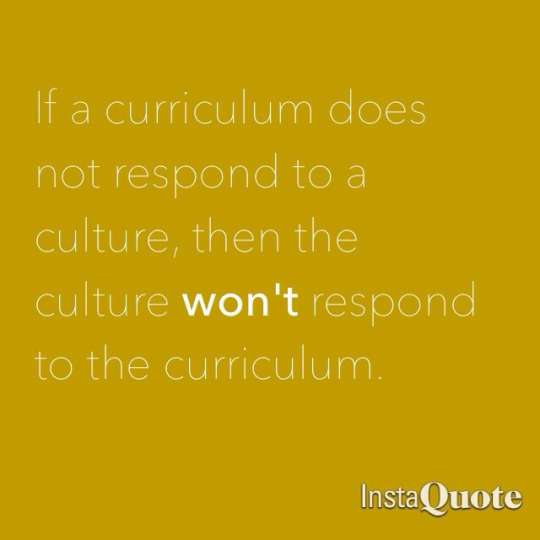
So, what is the first step? We look at the syllabus. Often times when discussing feminism, the target audience is young girls and women (again, by default, typically white). But intersectional feminist thought centers the experiences of all non men, especially marginalized demographics such as women of color and trans women. It must be clear that middle class, cis het, able-bodied white men (and women) cannot be the only people that exist in our curriculums. They are not the only authors who have stories to be told. They are not the only inventors with contributions to be celebrated. They are not the only leaders to write essays about. They are not the only survivors of tyranny with pain that cannot afford to be ignored. Only when we actively and intentionally engage our students in material that reflects these realities, which may or may not reflect that of the students, are we using our position as educators to develop and liberate young minds.
What we teach, however, is not the only line of defense against a white supremacist, patriarchal, academic agenda. How we teach is what separates intention from impact, especially when educating vulnerable populations (i.e., non men of color). Intersectionality is primarily concerned with making visible and audible the narratives of non men typically and systemically ignored. For the past three years, I have served as the program director of the L.A.C.E. Youth Leadership Program, educating low income, inner city Puerto Rican youth grades 6-12. I learned rather quickly that my students are far more knowledgeable about their realities than any college textbook could prepare me for. I learned that my voice was not the most important in the room, that they are aware of what matters to them – and if intersectional feminism teaches us anything, it is that people are the experts on their own lives and it is their voices that ought to speak for their experiences.
But if we are honest, this is not an approach that most students are accustomed to. Educators hold a privileged position over students in that we are the decided expert in the classroom. This can be especially dangerous when educating non men of color, for example, whose voices are often interrupted, undervalued and invalidated. If we are intent on cultivating multiple perspectives, especially within the context of intersectionality, it is vital that educators make an exerted effort to create safe spaces for these students while also allowing for more privileged students (whether that be due to their race or gender) to actively listen to their fellow classmate. Whether that includes house agreements created by the students in the efforts of structuring fair and impactful discussions, or creating seating arrangements that de-emphasize a primary speaker, or encouraging students to make “I” statements so to not speak in generalizations and encourage interpersonal dialogue that builds connections, there are several ways to ensure that all voices are heard and, most importantly, that no marginalized voices are spoken over.

One of the best teaching methods I have found to promote an intersectional agenda – and therefore an agenda rooted in self liberation, equity and community – is to pose students as the teachers. If the goal is to cultivate multiple perspectives within the feminist group, the educators cannot always be the main one talking. I refuse to facilitate every group discussion, especially when the topic is of something that does not directly impact me. In discussions about racism, for example, I - a white passing Boricua woman – would do better to co-facilitate alongside my Afro Boricua female student who is directly impacted by the topic at hand. In addition to cultivating leadership and public speaking skills, both she and her classmates are able to see a young black woman, who not only experiences racism, but sexualized racism at that, at the center of a discussion that has material consequences in her life. In this space, if only in this space, she has the power to structure a conversation about misogynoir amongst a mixed group on her own terms. That is the kind of leadership I want my students to have. That is the kind of feminism I want my students to practice.
I do not see intersectional feminism as some theoretical ideology reserved for dissertations and stimulating conversation amongst the academic elite. It is a tool. One that seeks to personalize the human condition and, if executed properly in the classroom, allows everyone an opportunity to transform what is often a mechanical, academic environment into a space that centers community building amongst youth on the collective desire for self-determination.
MRM Guest Blogger: Roslyn Cecilia Sotero
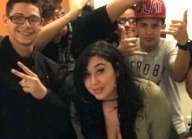
Roslyn Cecilia Sotero is a graduate of the University of Connecticut with a Bachelor of Arts degree in Human Development and Family Studies. During her undergraduate career, she served as Vice President and President of the Latin American Student Organization (LASO), which provided an array of cultural events and services to students of the Waterbury regional campus.
LASO opened up professional opportunities for Ms. Sotero when she connected with the Hispanic Coalition of Greater Waterbury, Inc. who at the time was looking to create a new youth program. Excited to be working within the local Latinx community, Roslyn drafted a program curriculum that was used as part of a $60,000 state grant application. For the past three years as Program Director of the LACE Youth Leadership Program, Roslyn has catered to the academic, professional, personal and cultural development of youth of color throughout Waterbury's public school system. And as is the vision of the Hispanic Coalition for local youth, Roslyn led the creation of three local art exhibits in CT's first Latinx Art Center, El Centro Cultural, where LACE students took the lead in educating the public about Latinx histories.
In addition to her director position, Roslyn continues to educate Brown and Black communities on social justice issues by serving on several panel discussions across CT, MA and NY specifically in regards to issues close to WOC, education equity, youth-led activism and anti-blackness within Latinx communities.
7 notes
·
View notes